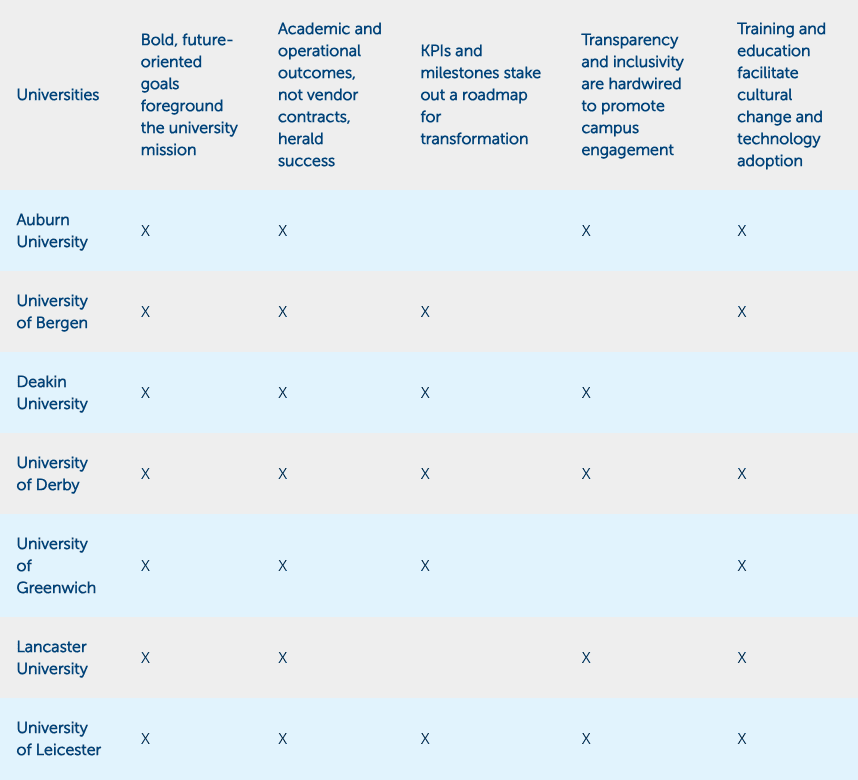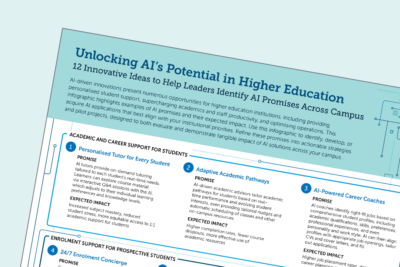For digital transformation success, start with a digital strategy that advances the university mission
Higher education’s appetite for digital transformation has grown significantly in the past few years. Help desk chatbots and app-based digital assistants have become commonplace as institutions look to boost efficiency and meet the digital expectations of students and staff alike.
The shift to widespread virtual instruction and operations in the wake of the coronavirus pandemic underscores that digital transformation is no longer a luxury but a necessity for business continuity. Institutional leaders who had not made necessary investments find themselves asking: where do I begin, and do I need a ‘digital strategy’?
The answer is yes.
Institutions must build more digital dexterity into their organisational structure—and the best place to start is by creating a plan. To ensure your digital strategy actually drives change rather than gathering dust on a shelf, it must focus on problem-solving innovations in service of the university mission. It should be rooted in business needs rather than the latest-and-greatest vendor pitches. Keep in mind the following rules of thumb about what makes a digital strategy.
What a digital strategy is not
- Technology-centric
- Purely aspirational
- A static document revisited only every 3-5 years
- An IT department strategy recast as ‘digital’
What a digital strategy is
- Customer-centric
- Action-oriented
- A living document, regularly reviewed and revised
- Malleable in structure to serve campus-specific needs
A digital strategy is not an IT department strategy that has been renamed ‘digital’. While IT strategy is about infrastructure service, cybersecurity, and systems, digital strategy is about business, value, and the customer.
Digital strategy: form versus function
Effective digital strategies vary in form across the higher education sector. They tend to be either standalone visions of digital transformation for the entire institution or folded into traditional strategic planning documents. And they can reflect either institution-wide goals or those of a particular department or division. An institution’s culture and appetite for digital change will impact both variables.
Standalone strategy…or not
In a standalone digital strategy, the focus is tightly scoped to the university’s vision for transforming the organisation with digital tools and technologies. A standalone strategy tends to be shorter and can be developed more quickly than a generic university strategic plan. The biggest downside of the standalone format is ‘strategy fatigue’, a problem when an institution pursues multiple—and in the worst case, contradictory—strategies.
Other universities embed digital ambitions directly into the holistic institutional strategic plan. This approach ensures the digital agenda is closely aligned with the overall university’s mission and goals. However, given the usual trajectory of institution-wide strategic plans, the digital component can suffer from both scope creep and a lack of specific next-steps.
Institution-wide…or not
Universities looking to signal a serious intent to transform the organisation with digital solutions may lay out institution-wide digital strategies. This approach prompts leaders at the highest level of governance to agree on priorities in a world of limited time and resources. It also forces conversations about student and staff experiences and journeys that cut across any one budgetary or managerial silo.
In other cases, such as when appetite for digital change may be distributed unevenly across campus, institutions have chosen to target digital strategies in specific departments or areas of focus, like Teaching & Learning or Recruitment & Enrolment. The tighter scope can help fast-track the strategy and subsequent action planning by setting out very specific objectives to achieve and investments to justify.
Hallmarks of effective digital strategies
Regardless of format, a digital strategy is only as transformational as it is actionable. In developing the strategy, focus on the goals it seeks to accomplish. To help you get started, make sure your digital strategy reflects five key hallmarks of those that are most effective:
1. Bold, future-oriented goals foreground the university mission
Does your digital strategy include details that allow you to complete these sentences:
- By 2025 our students and staff will __________________?
- By 2025 our professional services operations will __________________?
- By 2025 our University will be known for __________________?
2. Academic and operational outcomes, not vendor contracts, herald success
Does your digital strategy:
- Foreground institution-specific business needs, challenges, and goals?
- Cast a vision for a transformed future state, even if references to specific technologies are removed?
- Include only those technologies that solve for an institutional problem or fulfil a specific institutional goal?
3. KPIs and milestones stake out a roadmap for transformation
Does your digital strategy include the following:
- List of resources required to meet individual goals?
- List of teams or staff accountable for each action item?
- List of metrics and KPIs to track and review on a regular basis?
4. Transparency and inclusivity are hardwired to promote campus engagement
Does your digital strategy:
- List a cross-section of campus stakeholders to be engaged in the process of implementing the strategy (e.g., deans, administrators, academics, IT staff, students)?
- Outline the timeline and responsible parties for key phases of strategy development and execution?
- Encourage regular feedback and engagement in a variety of online and face-to-face channels, with plans to regularly communicate progress and update the strategy on an ongoing basis?
5. Training and education facilitate cultural change and technology adoption
Does your digital strategy include the following:
- A framework for prioritising digital literacy initiatives?
- Plans for educational programmes to rally constituents around a common understanding of the campus’s digital objectives?
- Plans for badges or other credentialing that recognises students and staff who complete digital training and workshops?
Digital strategy repository
While no one ‘perfect’ digital strategy exists, the table below summarises a repository of several best-of-the-best strategies that check the box on many of the hallmarks listed above. Use this guide for inspiration and suggestions on how to get your digital strategy off the ground.
-
Digital literacy
is the continual process of users becoming more confident and proficient in the use of digital tools and concepts. A digital literacy framework prioritizes the core areas where staff and students may need training, exposure, or guidance.

Auburn University
Auburn University’s university-wide strategic plan includes technology as one of its 7 major themes (page 4). Each key theme is elevated and discussed in context of the University’s goals, signalling technology’s role as an enabler for academic and operational outcomes, rather than an end-goal in and of itself (pages 6-15, Hallmark 2). For example, for their first goal to provide an ‘Elevated Auburn Experience’, technology-enhanced instruction is foregrounded as critical to the core University mission of educating students (page 6). The strategic plan includes an in-depth description of the campus-wide interviews and listening tours that contributed to the plan’s development, helping to hardwire transparency and engagement (page 17, Hallmark 4). Download the strategic plan here.
University of Bergen
The University of Bergen’s university-wide digital strategy complements the overall University strategy, centring decision-making around business need by defining digitalisation as ‘more than just digital tools…Digitalisation changes our culture and the way we conduct our business’ (page 3, Hallmarks 1 & 2). Each goal is supported by action items that chart out a plan for achieving each goal (page 9 onwards, Hallmark 3). The strategy highlights cultural change as a goal and calls out the importance of, and steps for, bolstering digital literacy (pages 7 & 11, Hallmark 5). Download the digital strategy here.
Deakin University
Deakin’s institutional strategic plan aligns each aspect of the University mission and strategy with digital goals. Every strategic pillar is supported by 3-4 goals and a visioning exercise outlining success (pages 9-15, Hallmarks 1 & 2). ‘Tracks’ associated with each goal (e.g., Learning Tracks, or Experience Tracks) offer KPIs to measure success (pages 9-15, Hallmark 3). In sections under the header ‘What does this mean for Deakin?” the document describes where the University has already made progress and investments, promoting transparency as to what has and has not worked in the past (pages 9-15, Hallmark 4). Download the digital strategy here.
University of Derby
The University of Derby’s Technology-Enhanced Learning Strategy delivers on all five hallmarks described above despite looking very different from most digital strategies. The document references the University’s strategic objectives, foregrounding the role of teaching and learning in advancing the core University mission (page 5, Hallmarks 1 & 2). The strategy is organised around 5 goals, each of which has a series of ‘enabling priority actions’ (page 4, Hallmark 3). The strategy is underpinned by ‘enablers’ (committed resources) and KPIs (page 5 & Annex A, Hallmark 3). Detailed appendices describe the methodology for creating the strategy, listing committees and stakeholders (page 14, Hallmark 4). The strategy includes plans for mandatory digital inductions and professional development courses for staff to fill gaps in core digital capabilities (page 7, Hallmark 5). Download the technology-enhanced learning strategy here.
University of Greenwich
Presented in a visually compelling design, the University of Greenwich’s digital strategy uses a Gantt chart to depict strategic objectives and driving principles that are supported by specific activities and workstreams (page 1, Hallmarks 1 & 2). The strategy includes a detailed visioning exercise for what success will look like by 2022, a list of KPIs, and resources required to realise goals (page 2, Hallmarks 2 & 3). In a section titled ‘Innovating for the Future,’ the strategy also outlines societal trends that will impact the higher education sector, accounting for the constant changes in digitalisation and emphasising the need to develop a culture of innovation and experimentation to meet future expectations. Greenwich underpins all of this work with a commitment to improving staff digital capabilities as a measure for success (page 2, Hallmark 5). Download the digital strategy here.
Lancaster University
Lancaster University’s digital strategy is, fittingly, presented via a digital web portal. An accompanying one-page document serves as an entry-point for understanding the University’s approach to digital transformation, saving potentially overwhelming details for those most interested in learning more. The document elevates the University’s digital vision and strategic goals, avoiding all reference to specific technologies and tools (Hallmarks 1 & 2). ‘Digital Enablers’ underpin the three main goals, emphasising digital literacy and cultural change (Hallmark 5). The web portal invites feedback from the campus community and encourages students and staff to engage with the University’s digital vision by contacting the Digital Lancaster steering committee (Hallmark 4). Snapshots of completed digital projects also foster ongoing communication with stakeholders about process (Hallmark 4). Access the web-portal here.
University of Leicester
The University of Leicester’s digital strategy delivers on all five of EAB’s hallmarks. It is a standalone strategy that complements the University’s overarching strategic plan. The strategy foregrounds the University mission and highlights a list of other divisional strategies that will work in tandem to achieve the University vision (page 3, Hallmark 1). It includes a list of KPIs that highlight what success looks like for stakeholders across the University, from students to decision-makers (page 9, Hallmark 3). The strategy highlights the importance of cultural change and digital literacy (page 8, Hallmark 5). The University also published a YouTube video explaining the digital strategy, promoting transparency amongst stakeholders with jargon-free explanations of DX. Download the digital strategy here, and access the video explainer here.
More Resources

How EAB's Edify Makes Your LMS Data Actionable

[International] Unlocking AI's Potential in Higher Education
